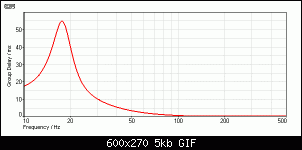I'm not talking about simple delay - like those slick auto-EQ systems sometimes adjust both EQ and distance for time arrival...
I'm talking about group delay, which is a variable by frequency, imposed by the vent - which comes on progressively - and that's the simple description of a normal vented box.
Once you get into a bandpass box, you have two vents, two tuning frequencies, a much more complex group delay plot.
...then an ABC box? I can only imagine the group delay - plus in that case, my belief is you have more group delay from the high-tune chamber, yet you have the direct output of the sub. In that case, I would believe it impossible to DSP out, no matter how fancy your DSP. It's only the bandpass box that I can even fathom it as possible, and I don't think people are doing that often, if ever.
For reference, here's a group delay plot for a simple vented box:







 Reply With Quote
Reply With Quote Still have it...
Still have it... 

